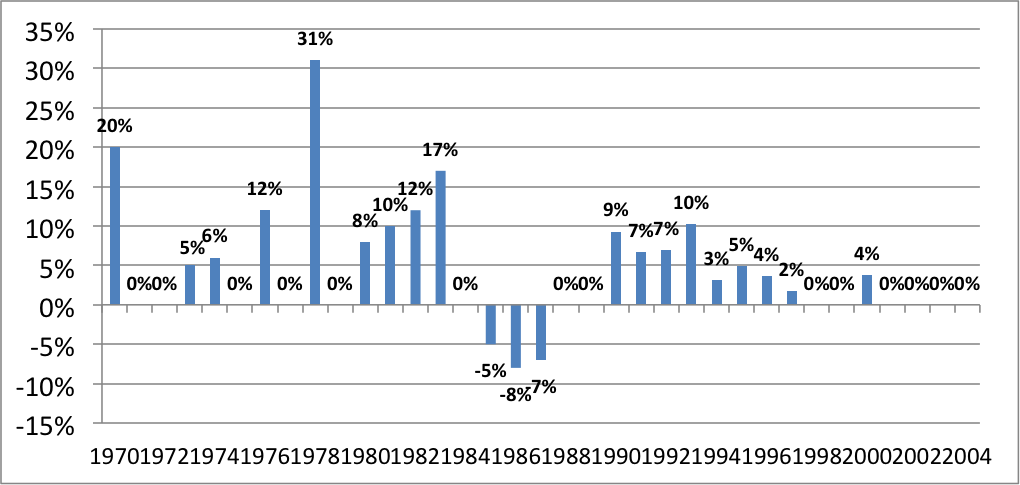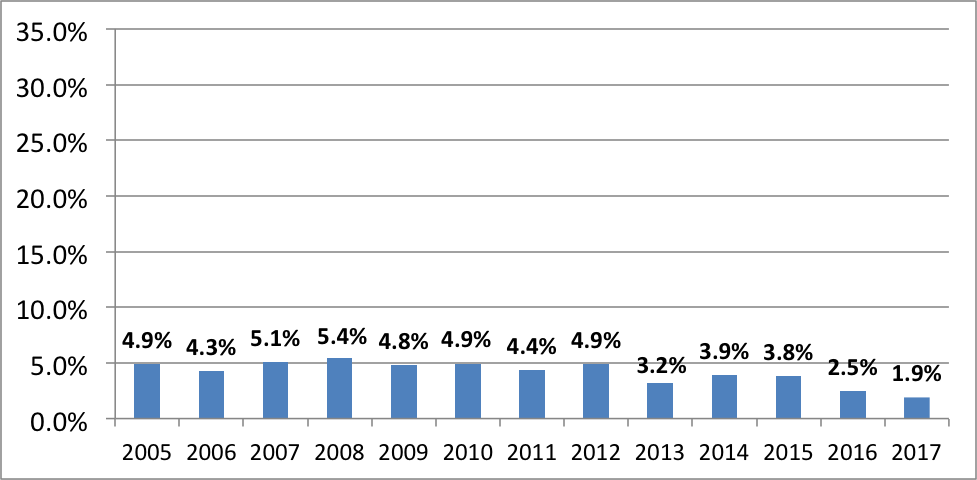Guest Post by Shane Hoffman
The water industry is entering a period of increasing costs and declining consumption. Inflationary costs for water utilities are far outpacing normal inflationary costs as measured by the All Items Consumer Price Index (CPI). The need to replace aging infrastructure such as distribution mains and treatment facilities is expected to increase dramatically in the future. Further, in recent years water-saving devices and appliances coupled with increased awareness of conservation have decreased indoor and irrigation-related consumption. These two factors lead to lower revenue and higher costs over the long term. Given these trends, many utilities will need to pass rate increases to ensure financial stability and continued delivery of safe, high quality water. But success in rate increases isn’t always easy: to accomplish this, water utilities will need to develop a comprehensive strategy involving the areas of planning, policy, and communication.

Historical chart of the Water and Wastewater Maintenance Consumer Price Index (CPI) compared to the All Items CPI from the Bureau of Labor Statistics (the Water and Wastewater Maintenance CPI is a subset of the All Items CPI).
Like many utilities, WaterOne faces the paradox of increasing costs and declining consumption. WaterOne is an independent public water utility serving the Johnson, County, Kansas area. WaterOne serves nearly 425,000 customers and is committed to providing save, reliable, and high-quality water supply with superior service and value. Below I describe how WaterOne used planning, policy, and communication in its last rate case.
Planning
Everything starts with a plan (or should start with a plan). For many organizations, the highest level plan is the strategic plan. First, it is imperative that the governing body be intimately involved in the development of the strategic plan. The strategic plan is the highest-level policy of an organization, and it is by definition, a governing body’s job is to set policy. More importantly, by involving the governing body in the development of the strategic plan, the board takes ownership of it and therefore buys into it fully. WaterOne held multiple work sessions with the board to develop its strategic plan.
WaterOne’s strategic plan is as follows:
Vision Statement: Setting the standard for utility excellence
Goal 1: Ensure a safe, reliable, high quality water supply
Goal 2: Provide excellent customer service
Goal 3: Be an employer of choice
Goal 4: Ensure financial stability and predictable rates
Goal 5: Continuously improve business processes
Goal 6: Proactively manage infrastructure
Goal 7: Be good stewards of the environment
Goal 8: Promote a safe work environment and establish a security conscious culture
Goal 4 requires that rates be high enough for stability, which will sometimes mean rate increases. The financial position must be stable enough for the organization to meet all of the other goals in the strategic plan and their related operational goals and Key Performance Indicators. For example, Goal 6 (Proactively manage infrastructure) has a Key Performance Indicator called System Renewal Rate. The System Renewal Rate measures the dollar amount of distribution mains that are replaced each year against a target amount set by an asset management model. The target amount increases every year as the need to replace infrastructure grows, which puts upward pressure on rates.
Also, Goal 4 promotes predictable rates, not just low rates. A sub-goal of Goal 4 is to “Develop effective annual budgets and long range plans”. WaterOne publishes and publically presents a schedule called the WaterOne Financial Overview (WFO) which details the current budget year’s revenues and revenue requirements along with the proposed rate increase, as well as those for the next five years. This sets the stage for future years’ rate increases so they are not a surprise. Various assumptions used in the modeling are also published on the WFO such as customer growth, gallons per customer, and inflation. There must be transparency to establish trust with the board and public.
Policy
Board-level policies and a comprehensive set of internal financial policies also help set the stage for rate increases. The following board policies have a direct impact on rates:
- “The Water District Board shall maintain water rates at a level which will provide net revenues from operations sufficient to annually produce coverage of at least two hundred percent (200%) of the current Annual Debt Service”
- “The Rate Stabilization Reserve exists to address unforeseen revenue shortfalls due to situations such as:
- Weather related water sales deficits
- Economic downturns
- Unexpected disaster or accident
- Unanticipated, but necessary emergency repairs and/or
- An unanticipated mid-year increase in such fixed costs as power, fuel or materials.”
The following are some of the internal policies (published in the annual budget book and approved by the Board) that have rate increase implications:
- The current year budget is projected based on a “normal” year.
- Historical revenue and expenditure trends are analyzed to define “normal”.
- Water rate increases are “smoothed” over a period of years to avoid rate spikes.
- WaterOne’s objective is to structure composite debt service to be approximately level on a year-to-year basis where appropriate, which avoids significant roller-coaster types of increases and decreases in debt service and enables water rates to remain relatively stable (smoothed) over time.
- One-time revenues should not be used to fund normal, ongoing operations and consequently are not included as a revenue source in the development of the annual budget.
In the first bullet above, projecting based on a “normal” year prevents revenues and expenditures from being budgeted too aggressively and thereby not recovering the full cost of service. In the second bullet, “smoothing” helps prevent the temptation to artificially cut funding in order to avoid a rate increase, only to “pay the piper” later with a large rate increase. It essentially sets up a foundation for smaller rate increases every year. Smoothing rates increases are an effective way to keep up with increasing costs and avoiding public backlash for large rate increases. Notice the two graphs for rate increases below. One is 1970-2004, and the other is 2005-2017, after WaterOne adopted the “smoothing” policy. The key point to take away is that the averages for these two periods are very close.
Historical Water Rate Increases 1970-2004

Historical Water Rate Increases 2005-2017

Communication
The last step is to communicate to stakeholders in an effective manner. WaterOne uses several methods in the public hearing to communicate the value they are getting for the rates they are paying, including:
- Stating the impact on the typical customer per month (e.g. $1.50 per month)
- What the budget is spent on
- What is causing the rate increase
- Customers served per employee history
- Comparison to Water/Wastewater Maintenance CPI
- Comparing rates to neighboring water utilities
- Comparing monthly bill to other household costs (e.g. cable, electric, gas)
Conclusion
Passing rate increases requires a comprehensive strategy that relies on sound planning, policies, and communication. Sometimes the mindsets of stakeholders and utility culture may need to shift in order to be successful. Transparency and sound analysis must be used to develop trust over time. If the needs are real and made apparent to decision makers, hopefully the best interest of the utility and its ratepayers will be the outcome of everyone’s efforts.
Shane Hoffman is a Senior Financial Analyst at WaterOne; his current duties include rate setting, long-term forecasting, sizing and structuring bond issues, and annual budget management. He has worked with WaterOne for 17 years. He is a certified Public Finance Officer and earned a B.A. in Finance and M.B.A from Kansas State University.
More Posts on Rate Increases:
- Finding the Path to the Next Rate Increase
- Get What You Need: Survey results on communicating the need for a water rate increase
- The Power of Words: Survey Results on Communicating the Need for a Water Rate Increase Part 2
- Eight Communication Strategies to Help Water Utilities Get the Rates They Need
- In it for the long-haul: Water rate approvals from real communication with boards
- Multi-year Rate Increases: “Taking the Politics Out?”
- Water Rate Increases Among 1,961 Utilities in Six States in the Last Decade
- Cost-Indexed Rate Increases





Leave a Reply